Navigate This Post
Can you resurrect a Springfield 1911 from the dead? Perhaps a better way of putting it might be, can one take a Springfield Armory M1911 .45 acp pistol that has sat dormant in a gun safe for more than twenty years and make it run again? Yes, this is a real situation. No, I don’t own any firearms that have sat unused for twenty years. The gun in question belonged to someone else.
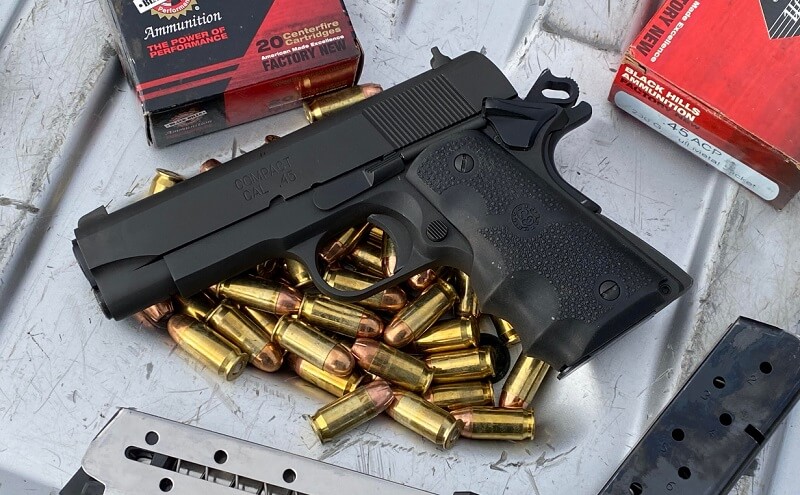
Springfield M1911-A1 Compact, brought back to life after safe coma.
Springfield Armory M1911-A1 Compact
Help us combat Censorship by joining our Newsletter
The most prevalent single-action .45 acp pistol is an M1911-A1 model, not the M1911 which was replaced by the improved version shortly after John Browning released it. The specific firearm we will consider for this article was passed down by one member of the extended family to my oldest son and daughter-in-law.
As far as specifications, the subject at hand came from Springfield Armory USA. It is a single-action, semi-automatic, .45 ACP pistol with a 4 inch barrel. The pistol is fed by a single-stack, 6-round magazine. Additional features include a rounded “combat” hammer, 3 Dot “toddler” sights, and the factory grip stocks were checkered black polymer. The manual controls; magazine release button, slide stop, thumb safety and trigger are traditional M1911-A1 designs. Sometime after buying the gun, the original owner added Hogue wraparound rubber grips.
This is what we were dealing with.
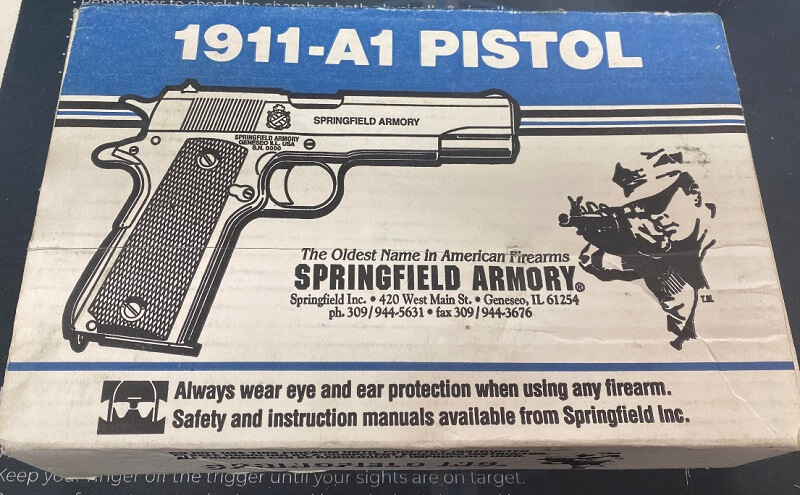
After nearly 30 years, the pistol was in the original box.
Bringing the Springfield 1911 out of a Safe Coma
I might not be fair to refer to this gun as having been dead. That might lead you to believe that the gun was inoperable. When I opened the original factory box and picked up the gun for inspection, I popped out the magazine; empty. Next I grabbed the rear of the slide to pull it back, allowing me to inspect the chamber. The slide did not move. The hammer was down and the safety was in the off position. I know that compact .45 acp guns have stiff recoil springs, but this was ridiculous.
My next step was to move to my work bench, put the front of the slide on a padded cleaning mat and push down. Success! I was able to move the slide a half inch or so. Now I really pushed hard and was able to activate the slide lock. The chamber, as expected, was empty.
Now I tried to pull back on the slide to release the slide lock. No dice. The slide would not move. I pushed down on the slide lock and whacked the ass end with a rubber mallet. That did it. Now the hammer was back in the cocked position. I picked a safe direction and pressed the trigger. The hammer did not fall, but it did release. I found that I needed to actually push the hammer forward with my thumb to get it to move.
I must stress that there was ZERO rust or corrosion on the gun. None. Nada. Despite having a parkerized finish and not having been fired in over twenty years, there was not a blemish on the finish.
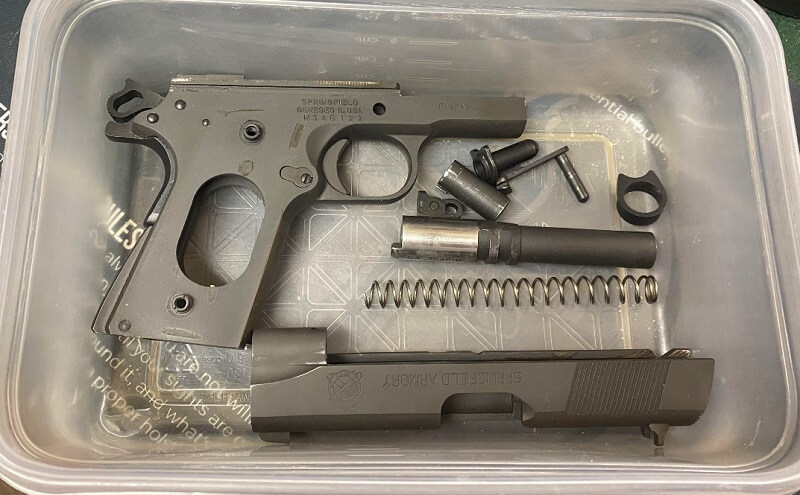
Springfield 1911 completely stripped for resurrection.
Stiff as a Board, Dry as a Bone
My initial inspection indicated that the Springfield 1911 had been lubed/oiled and then stored in a cool, dry area, for decades. I knew that my primary task would be to completely disassemble the gun so that it could be soaked in solvent. Reaching once more for the rubber mallet, after the slide lock was removed, I tapped the slide off of the frame. The firing pin, spring, an extractor were removed from their place in the slide.
As for the frame, I removed the Hogue grips so that the solvent could get in and soak all the springs and lower parts. The barrel and recoil spring were set aside as well. Borrowing a plastic tub from the kitchen (don’t tell Mrs. Markel), I placed all of the 1911 parts in it and poured in enough FrogLube solvent to cover them. FrogLube solvent is non-toxic and it is not caustic, I knew I could leave all the parts soaking and it would not harm them. That is just what I did, soak the parts for 24 hours.
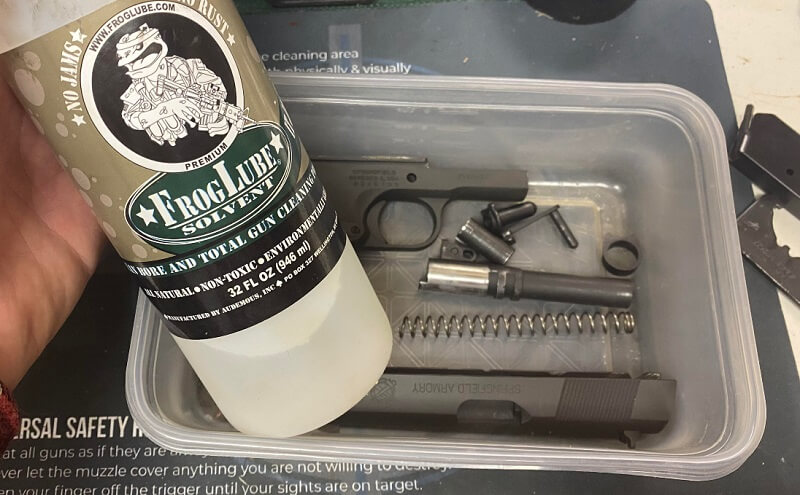
The pistol was stripped down and soaked in FrogLube solvent for 24 hours.
Inspection, Reassembly, and Lube
On the second day of my Springfield 1911 project, I dried out all of the parts and then visually inspected them piece by piece. I did not see any signs of wear or damage on any of the components. That fact was not exactly shocking, but it was good to verify that no structural or mechanical problems were present.
Now came reassembly. I reached for a bottle of red EDC-CLP and applied it with a general purpose brush to the slide rails and everywhere that metal moved against metal. As a side note, I have been using the EDC-CLP for over a year now on handguns and rifles including AR’s and AK’s. Thus far I am impressed by the performance of the gun lube.
Reassembling a compact M1911 pistol is a bit more difficult than a standard, full-sized gun. There is considerable amount of spring tension in the recoil spring of a compact .45ACP. Also, the Springfield Armory recoil buffer design is a bit different than the original. Soon the gun was lubricated and completely put back together. I performed a quick function check and was ready to hit the range for live fire testing.
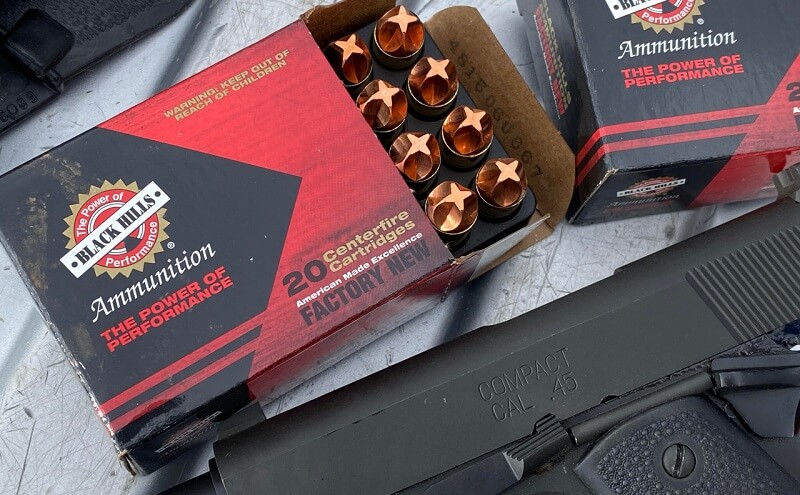
Back from the dead; the Compact 1911 performed surprisingly well, feeding the Black Hills Honey Badger ammunition.
Range Testing the Springfield 1911
The next day was clear and cold, but there was no snow to block the range road. I loaded up the Springfield 1911, grabbed a couple spare magazines, a can of .45ACP ammunition and my range bag.
At the time of this writing it has been 35 years since I was introduced to the M1911-A1 pistol. My first firearm training course was 40 hours long and I completed it using a rented WWII surplus, GI stock M1911 .45. When I entered the Marine Corp a year later, the M1911A1 was still the issued sidearm and I carried one for two years before switching to the M9 Beretta.
After leaving active duty, I entered the Police Academy and got on with a small municipal police department. At the time, officers were required to purchase their own handguns and duty gear. In December of 1991, I bought a full-sized Springfield Armory M1911-A1 pistol. I carried that gun for about ten years before switching to a GLOCK. During my time as a gun writer for numerous publications, I probably tested and reviewed 25 to 30 other M1911-A1 guns in Service, Commander, and Officer size.
I relate all of that information to let you know that I have a rather extensive background with the platform. My experience with the M1911-A1 is that the smaller you make the guns, the more prone to stoppages they become. Another reality is that out-of-the-box 1911’s tend to be finicky eaters, particularly when it comes to jacketed-hollow point bullets.
FREE COURSE
Master the Fundamentals with 7 Training Tips That Could Save Your Life
Sign up now and get started with the course.
Bringing Back the Dead.
At the range I loaded up the factory Springfield 1911 six-round magazine with 230 grain full metal jacket (Ball) ammunition from Black Hills. If the gun stopped, I felt sure it would not be an ammo issue. Holding the pistol with two hands, I fired at a steel silhouette, ten yards away. Six shots, six hits, no stoppages. Time to repeat the process. She’s still running good.
I took a larger, eight round magazine and filled it with a variety of ammunition; ball, jacketed-hollowpoint, Hydra-Shok, etc. Again, no issues. Next I fired with my right hand only. Still good. Then my left hand only. No problems. Seriously exciting stuff. I loaded up two magazines with the new Black Hills Ammunition Honey Badger ammunition. Sixteen shots, no stoppages.
Final Thoughts on Resurrecting the Springfield 1911.
All told, for the first range session this gun had seen in twenty years, I put about 100 rounds through it. Using ammunition from Black Hills, Federal, Fiocchi and Winchester, I experience no problems or issues. To modern 9mm shooters, this might not seem like a big deal. But, to those with experience shooting 1911’s understand, particularly compact guns, know the results were stellar.
I can officially report that the patient is not dead and no longer in a safe coma. This older Springfield 1911 seems to have come back to life with the vigor it once had decades before.
Professor Paul Markel
Latest posts by Professor Paul Markel (see all)
- Tactical Masturbation: Top 3 Stupid Human Tricks - July 8th, 2024
- Blood Trail: Fearless Fiction - June 21st, 2024
- SOTG and SB Tactical Celebrate Brace Ruling - June 20th, 2024
- Shotgun Accessories: Practical and Useful - June 14th, 2024
- Tactical Rifle Tips: Transition Drills - January 5th, 2024






Since I’ve been around 1911 pattern pistols for a decade or so longer than you I reckon I can make a comment or two 😉
The pistol was not ‘dead’ – it was merely hibernating. All it needed was a bit of TLC and it is back up and running.
FWIW I did a similar ‘wake-up’ on a vintage Colt Detective Special about 40 years ago. It was in similar deep sleep and likely had been for at least a decade. End result was pretty much the same even without modern cleaning supplies. I felt comfortable enough to carry it for my off duty piece – yep back in the days when wheel guns reigned.
Fun read and a few pearls of wisdom imparted in it.
I’ve got 100 rounds of that Honey Badger, ran through 20 in a full size Springfield without issue.